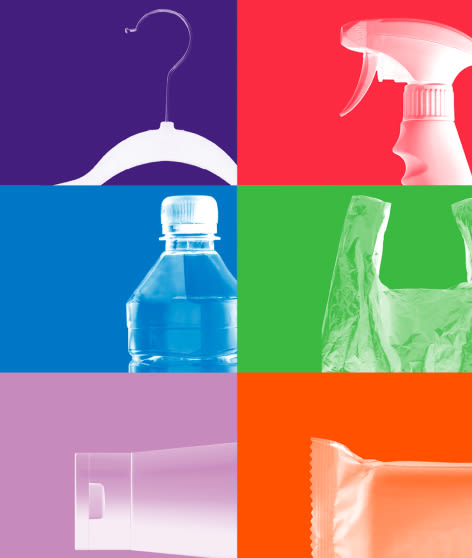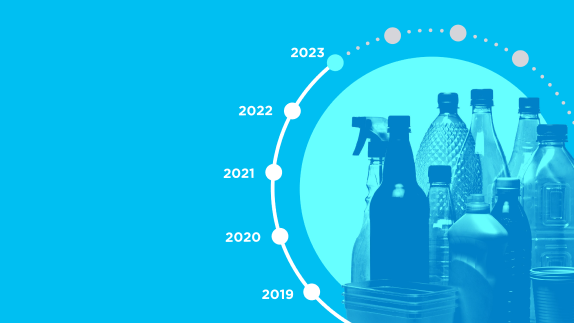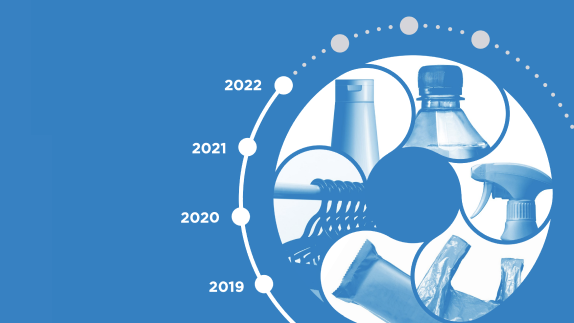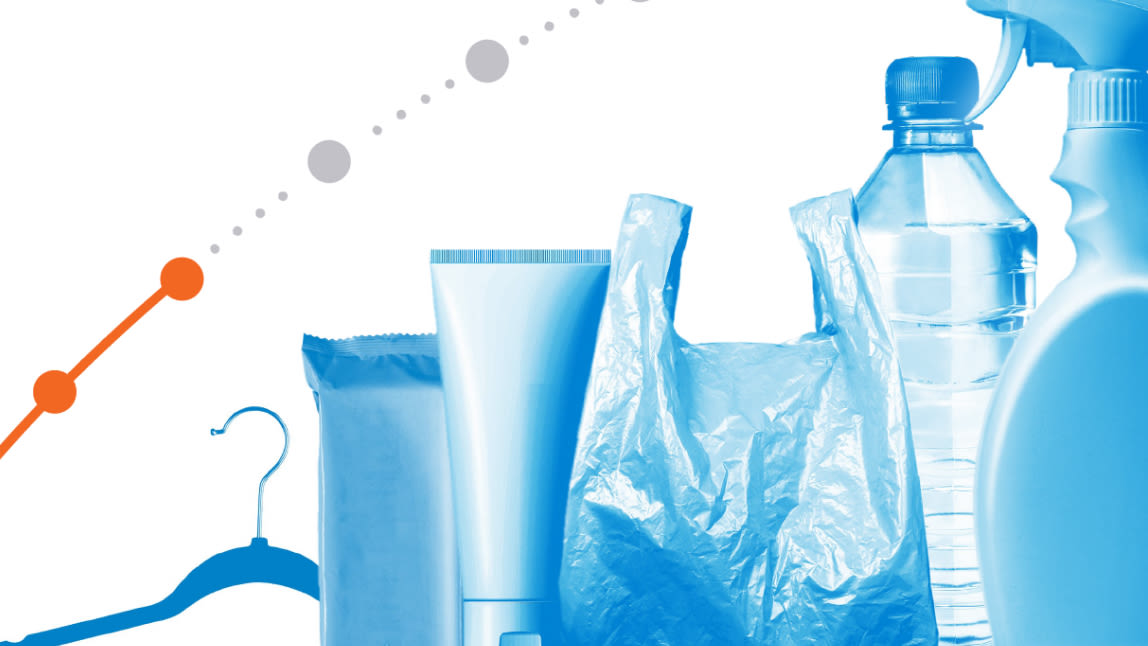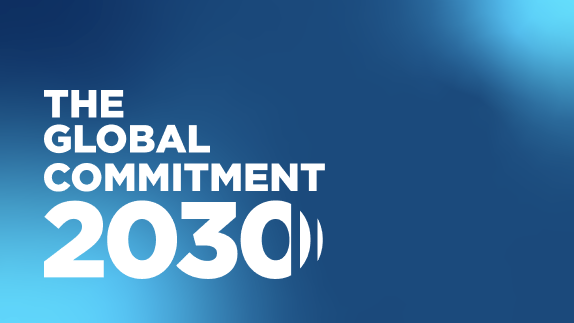Published as part of the Global Commitment Progress Report 2022 by the Ellen MacArthur Foundation and UN Environment Programme
Overall trends
In 2021, virgin plastic packaging increased on average by nearly 4% compared to 2020, driven by half of apparel signatories. The amount of virgin plastic packaging used in the apparel industry increased in 2021 for half of the signatories, notably due to factors such as business signatories reopening physical stores as well as an increase in online sales. However, compared to 2018, there was an overall decrease in virgin plastic packaging (-35%), which was facilitated by a decline in plastic packaging weight and increase in post-consumer recycled (PCR) content.
Reusability and recyclability of apparel companies’ plastic packaging increased by around 3 and 7 percentage points, respectively, between 2020 and 2021. These increases were driven by the expansion of closed-loop systems to reusereuseThe repeated use of a product or component for its intended purpose without significant modification. and recyclerecycleTransform a product or component into its basic materials or substances and reprocessing them into new materials. their hangers, and/or the elimination of non-recyclable plastic packaging such as polybags. However, progress varied amongst the sector: at least half made no progress or increased their share of reusable and/or recyclable plastic packaging elimination efforts have focused on lightweighting rather than reuse.
Actions to accelerate progress
Increased emphasis on innovation away from non-recyclable and single-use packaging. The apparel sector is a large user of non-recyclable plastic packaging, representing 55% of their portfolio on average. Currently, the necessary infrastructure does not exist to recycle PS used for hangers and flexible plastic packaging used for polybags. As a result, emphasis should be primarily focused on innovating away from these types of packaging through elimination or reuse.
Signatories should carefully assess material substitution (e.g. to paper-based packaging) and ensure this is part of a broader packaging strategy that moves away from single-use applications where possible. While companies have eliminated a large portion of their plastic packaging, this was largely through paper substitution, which replaces one type of single-use packaging with another, often with no significant reduction on the need for virgin materialsvirgin materialsMaterials that have not yet been used in the economy.. Material substitution as an elimination approach to single-use plastic packaging should be considered cautiously, fitting into a broader plastic packaging reduction strategy that prioritises efforts to design out the need for single-use packaging to begin with.
Reduction targets
Average change in virgin plastic packaging from 2020 to 2021: +3.7%
In 2021, signatories have set 2025 targets to reduce their virgin plastic packaging (i) or total plastic packaging (ii) as part of the mandatory requirements to remain in the Global Commitment.
Trends
In 2021, four out of the six apparel signatories set a virgin reduction target, by 46% on average. Two signatories set targets to reduce the total amount of their plastic packaging.
Between 2020 and 2021, the sector reported an increase in virgin plastic of 3.7% which was notably being due to the growth in total plastic packaging use outpacing progress on recycled content for three signatories.
Looking at the overall trend from 2018 to 2021, the sector decreased its virgin plastic packaging by an average of 35%, driven by a decrease in plastic packaging.
Virgin reduction targets aim to decrease the total weight of virgin plastic in packaging, and should be underpinned by efforts on reuse and elimination in addition to increasing the use of recycled content.
Total reduction targets aim to reduce the total weight of plastic packaging.
For more information about the reduction targets read the 2022 Progress Report.
Elimination of problematic or unnecessary plastic packaging
Trends
Apparel signatories most commonly reported targeting single-use hangers, carrier bags, plastic windows used in cardboard boxes, consumer-facing plastic film used in plastic packaging, and B2B film (used, for example, to wrap pallets).
Of the 14 reported examples of elimination of plastic packaging, a minority (three) involved direct elimination or implementation of reuse models to avoid the use of single-use packaging to begin with. The majority of examples involved the elimination of plastic packaging through paper substitution.
Highlights
H&M Group, Inditex, and Stella McCartney have reduced their use of single-use hangers through a closed-loop system. H&M Group plans to fully eliminate PS, multilayer materials, consumer-facing and clear mono-material plastic films, labels, stickers, and sleeves by 2025, along with exploring avenues to replace garment polybags used by suppliers to send garments to distribution centres by testing different materials, designs, and system approaches.
To eliminate single-use plastic packaging from their customer interface, Inditex is eliminating consumer-facing clear and mono-material plastic films, plastic windows from cardboard boxes, perfume wrappers, and labels/stickers. LPP plans to eliminate more than 50% of its consumer-facing clear and mono-material film by 2023.
Moving from single-use towards reuse models
Reusable plastic packaging in 2021: 12% (▲2.6pp vs 2020)
Trends
Apparel signatories have the highest proportion of reusable plastic packaging compared to other sectors, largely due to the implementation of B2B reuse models for hangers or pallets by half of the sector’s signatories.
Beyond reusable hangers used internally, a few companies are starting to explore reuse models for other packaging, including cosmetics. However, only two signatories (Stella McCartney and Inditex) increased their share of reusable plastic packaging and the number of reuse pilots implemented or planned remains limited: three out of the six sector companies are planning reuse pilots by 2025 and only one is planning more than three (H&M Group).
Highlights
Stella McCartney reported the highest increase (+15 percentage points) in reusable plastic packaging in the sector, primarily through the expansion of hanger reuse across its offices, stores, and wholesale partners. The company plans to eliminate unnecessary hangers, increase hanger reuse in warehouses, and expand their hanger reuse programme to the consumer interface.
H&M Group has established a new team that focuses on resources optimization where exploration of reuse solutions is one activity. The company is exploring reusable packaging for online packaging, B2B internal transport as well as for cosmetics and household products through powder and liquid concentrates and refillable make-up. The plan is to test up to 10 reuse pilots across the packaging portfolio by 2025
100% of plastics packaging reusable, recyclable, or compostable (RRC)
RRC in 2021: 57% (▲10pp vs 2020) || 2025 target: 100%
Trends
Signatories’ increase in the average proportion of reusable, recyclable, or compostable plastic packaging was driven by growth in reusable and recyclable plastic packaging.
Three signatories (50%) increased the recyclabilityrecyclabilityThe ease with which a material can be recycled in practice and at scale. of their plastic packaging; Stella McCartney saw the most progress on this front by eliminating non-recyclable plastic packaging. However, the other half of signatories did not progress on increasing this share. As a whole, the sector has a high proportion of non-recyclable plastic packaging (55% on average) including PS hangers, e-commerce bags, and carrier bags which needs to be addressed through direct and innovative elimination, coupled with scaled recycling infrastructure.
Highlights
Superdry plans to expand the removal of polybags at its distribution centres to cover e-commerce orders in addition to retail, and is working on boosting recycling rates in their closed-loop recycling system, as well as collaborating with wholesale partners to implement similar practices.
H&M Group is modelling a tool to provide a circular score for all packaging used based on its application, the extent to which it incorporates circular design principles, amount of material and feedstock used, and its technical recyclability. The company is collaborating with external partners to redesign hangers to ensure they are reused or recycled, and is working with collection and sorting companies to recycle plastic collected at its distribution centres.
Post-consumer recycled content (PCR) targets
PCR in 2021: 45% (▲16pp vs 2020) || 2025 target: 52%
Trends
Five signatories (83%) have increased their proportion of PCR content since 2020 with companies incorporating more recycled content in their flexible plastic packaging.
One signatory (Inditex) reported a decrease in PCR content, due to the elimination of plastic bags from their portfolio which had previously consisted of recycled content.
Highlights
H&M Group increased PCR content across plastic packaging for online sales, cosmetics, and personal care packaging. The company plans to expand this transition across more product lines and incorporate 100% recycled content into their master polybags.
Superdry increased its proportion of PCR content by 22.5 percentage points by eliminating plastics with low levels of recycled content and working with a polybag supplier to boost the collection and recycling of used polybags into new ones, mainly from e-commerce returns. Additionally, the company reported sharingsharingThe use of a product by multiple users. It is a practice that retains the highest value of a product by extending its use period. information on collection and recycling processes with consortiums, such as the British Retail Consortium (BRC), to enable other brands to benefit from access to such information.
Additional information
Apparel sector compared to other sectors
Endnotes
General note: Some quantitative metrics for 2020 might differ from those reported in the sector insights published in 2021 as some companies updated prior years’ metrics due to improvement in methodology, merger and acquisition or scope expansion.
The change in virgin plastic packaging represents the non-weighted change reported by all signatories in the sector.
For signatories where data on key metrics was lacking for 2018 on virgin plastic packaging, data was extrapolated based on the metrics’ average for the group.
In this document, the quantitative metrics for 2018, 2021, and 2025 targets represent the non-weighted average of the data reported by all signatories in the sector.
To be claimed as recyclable/compostable according to the Global Commitment definition of recyclable/compostable ‘in practice and at scale’, packaging needs to meet the thresholds of being recycled/composted at a 30% rate across multiple regions, collectively representing at least 400 million inhabitants. For more information, see ‘How are recyclability and compostability assessed in the Global Commitment?’ in the 2022 Progress Report.
In this document, the quantitative metrics for 2022 and 2025 targets represent the non-weighted average of the data reported by all signatories in the sector.
PS = Polystyrene.
In this document, the quantitative metrics for 2022 and 2025 targets represent the non-weighted average of the data reported by all signatories in the sector.
HDPE= High-density polyethylene; PE = Polyethylene; PP = Polypropylene; PS = Polystyrene.
The 2025 target reported is for sector signatories with virgin plastic packaging reduction target, and as such excludes signatories with a total reduction target.
Disclaimer
This report has been produced by the Ellen MacArthur Foundation (the “Foundation”). The Foundation has exercised care and diligence in preparing this report, based on information it believes to be reliable, but makes no representations and gives no warranties, assurances or undertakings (express or implied) in connection with it or any of its content (as to its accuracy, completeness, quality, fitness for any purpose, compliance with law, or otherwise).
The Foundation does not monitor or moderate any external websites or resources linked or referred to in this report. This report does not purport to be comprehensive and none of its contents shall be construed as advice of any kind. Any reliance on it is at reader’s own discretion and risk. All information on signatories’ progress in these sector insights has been provided by the relevant signatories and has not been audited or verified by the Foundation or UN Environment Programme (UNEP). Each signatory is responsible for the information it submitted.
The Foundation and UNEP do not warrant that all information submitted by individual signatories is contained or represented in this report and, without limiting the generality of the foregoing, the Foundation may: (i) have excluded data which it believes to be inaccurate; (ii) have excluded from year-on-year calculations data from signatories which have not reported data in both years; and (iii) have normalised information to produce the aggregated and averaged statistics featured in this report. Further, if a signatory has not reported by the relevant deadline(s), its data will not be included in this report. If you are a signatory and you believe there has been an error in the reproduction of the information provided to us by your organisation, please contact us as soon as possible at reportingGC@ellenmacarthurfoundation.org, or your contact at UNEP.
To the maximum extent permitted by any applicable law, the Foundation, each entity within its group and each of its associated charities and their respective employees, workers, officers, agents and representatives disclaim in full all liability for any loss or damage of any kind (whether direct or indirect and whether under contract, tort, breach of statutory duty or otherwise) arising under or in connection with this report or any of its contents.
Contributions to this report by any third party do not indicate any partnership or agency relationship between that contributor and the Foundation, nor the endorsement by the Foundation of that contributor or the endorsement by that contributor of this report’s conclusions and recommendations.
The Foundation is not a supplier of, or otherwise affiliated with, and does not recommend or endorse, any third party or the products or services referred to in this report.
About these sector insights
This document presents insights and data on the progress made by apparel signatories listed below to achieve their commitments on plastic packaging. This document is part of the 2022 Global Commitment Progress Report.
About the Global Commitment
The Global Commitment is an initiative led by the Ellen MacArthur Foundation, in collaboration with the UN Environment Programme. Through the Global Commitment, businesses and governments commit to change how we produce, use, and reuse plastic. They will work to eliminate the plastic items we don’t need; innovate so all plastic we do need is designed to be safely reused, recycled, or composted; and circulate everything we use to keep it in the economy and out of the environment. Learn more
Global Commitment signatories reporting in this sector
ASOS
H&M Group
Inditex
LPP
Stella McCartney
Superdry Plc



